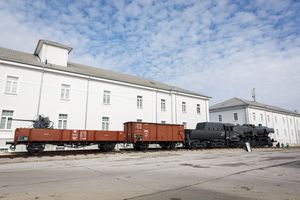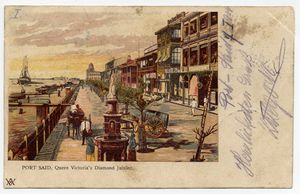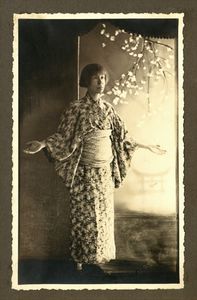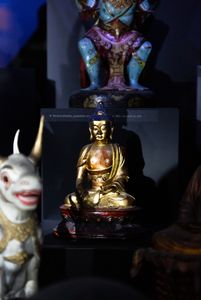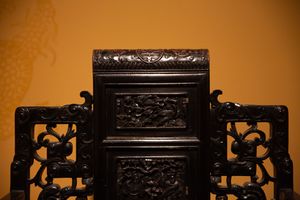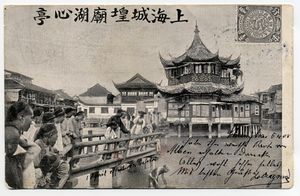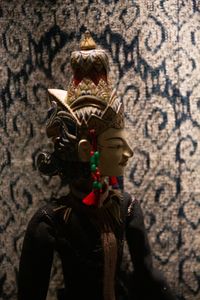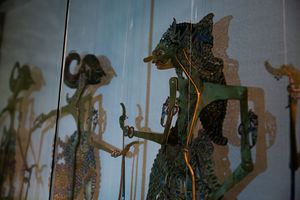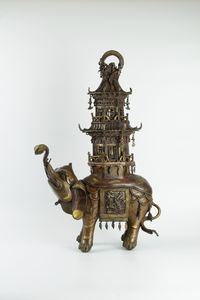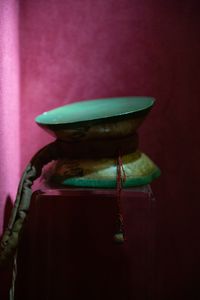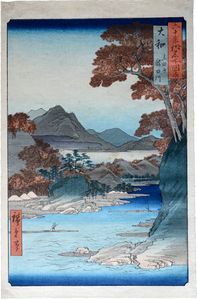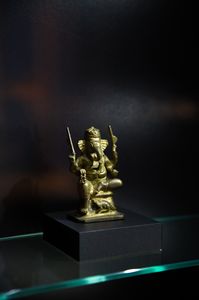Artifacts
96 images in Museum objects.
The building of today's Nova Gorica railway station, a postcard from the early 1920s. (Photo from the regional library portal Kamra.si.)
The Slovenian Computer History Museum's collection storage, Ljubljana.
Exhibition at the Slovenian Computer History Museum, Ljubljana.
A portrait of Alma Karlin taken in the period 1920–1930. Part of the Manuscript Collection of the National and University Library, visible also on Kamra.si.
Female nude, by Zdenko Kalin and Echo, by Karl Putrih.
Specimen from the manuscript collection of the Archives of the Republic of Slovenia in Gruber Palace
Mill wheel, The Cerkno Region Through the Centuries permanent exhibition at Cerkno Museum presenting the historical development of the Cerkno region, 2004
The Cerkno Region Through the Centuries permanent exhibition at Cerkno Museum presenting the historical development of the Cerkno region
The Wheel – 5200 Years, an exhibition view. City Museum of Ljubljana, 2013
Zasavje Museum, Trbovlje, permanent exhibition of Hrastnik Puppets and puppeteers, opened July 2002, containing more than 120 artifacts from the 30 year history of the puppet theater founded in 1947
A model of the bronze situla from Vače (500 BC), a pedagogical kit from the Dolenjska Museum Novo mesto, made by a visitor at the Cultural Bazaar (2014)
The writer Anton Ingolič's (1907–1992) memorial room at Slovenska Bistrica Castle, 2014
The Banner Room in the Slovenska Bistrica Castle
France Cerar's photo documentation presented at the National Museum of Contemporary History, 2014
A skeleton of a young Fin Whale found in Piran Bay in 2003, the largest exhibit in the Slovenian Museum of Natural History, 2011-2012
Prison doors, The Cerkno Region Through the Centuries permanent exhibition at Cerkno Museum presenting the historical development of the Cerkno region
Parts of a skeleton of young Fin Whale found in Piran Bay in 2003, the largest exhibit in the Slovenian Museum of Natural History
Slovene Museum of Christianity, medieval scribe, 2008
Assembling of a skeleton of young Fin Whale found in Piran Bay in 2003, the largest exhibit in the Slovenian Museum of Natural History
Slovene Museum of Christianity, permanent exhibition, 2012
Dairying accessories, The Cerkno Region Through the Centuries permanent exhibition at Cerkno Museum presenting the historical development of the Cerkno region, 2004
Wooden model of the Luka truck, built by TAM car factory (Tovarna avtomobilov Maribor) in the 1950s and named after Franc Leskošek - Luka, the national hero. From the Memorial to Maribor Industry – Industrial Maribor in 20th Century permanent exhibition
Slovene Museum of Christianity, permanent exhibition, 2002
The Wheel – 5200 Years, an exhibition view with the models of Herman Potočnik's space station drawings from 1929. City Museum of Ljubljana, 2013
Slovene Museum of Christianity, urbarium, 2010
The oldest wheel with an axle found at the Ljubljana Marshes (20 km south of Ljubljana) in 2002. The axle made of oak wood is 120 cm long. City Museum of Ljubljana, 2013
The world's oldest wheel found at the Ljubljana Marshes in 2002 is 5,200 years old, according to radiocarbon dating. The wheel with a radius of 70 cm is on display at the City Museum of Ljubljana, 2013.
Scabbard, 3rd Century BC, from tomb no 115, Kapiteljska njiva archaeological site administered by Dolenjska Museum Novo mesto
Slovene Museum of Christianity, urbarium, 2010
Alma Karlin's embroidery from the Celje Museum of Recent History collection
Mammoth skeleton, Slovenian Museum of Natural History symbol
The bust of Anton Janša (1734-1773), the beekeeping mentor, at the Museum of Apiculture, Radovljica
The writer Anton Ingolič's (1907–1992) memorial room at Slovenska Bistrica Castle, 2014
A half-century old classroom at the Slovenska Bistrica Castle
Artifacts featured in the permanent exhibition Between Nature and Culture, Slovene Ethnographic Museum.
Artifacts featured in the permanent exhibition Between Nature and Culture, Slovene Ethnographic Museum.
A sketch of the Japanese Dharuma figure in the margins of Alma Karlin's unpublished manuscript on religious beliefs and practices in the Far East. Alma Karlin Estate, Manuscript Collection, National and University Library, MS 1872.
A Chinese wooden mirror in the Skušek Collection, Slovene Ethnographic Museum.
Seal from a manuscript specimen of the collection kept at the Archives of the Republic of Slovenia in Gruber Palace
The bronze situla from Vače (500 BC), an original housed at the National Museum of Slovenia, is accessible to wider public at the Ljubljana Castle as a part of the Slovene History exhibition, 2010
Ship model from the workshop of the Jesuit priest Gabriel Gruber exhibited at Sergej Mašera Maritime Museum, Piran, 2020.
Exhibted objects at Park of Military History Pivka, 2020.
Exhibited objects at Park of Military History Pivka, 2020.
Aircraft wing, Park of Military History Pivka, 2020.
Yugoslav submachine guns exhibited at Park of Military History Pivka.
Oxygen tanks used by bomber crews exhibited at Park of Military History Pivka.
Ship model exhibited at Sergej Mašera Maritime Museum, Piran, 2020.
Anti-tank guns, Park of Military History Pivka, 2020.
Smiling Buddha, Qing Dynasty, Skušek Collection, Slovene Ethnographic Museum.
Artifacts featured in the permanent exhibition Between Nature and Culture, Slovene Ethnographic Museum.
Detail of the Emperor's Dragon Robe, 19th century, Qing dynasty, from the Skušek Collection, Slovene Ethnographic Museum.
Artifacts featured in the permanent exhibition Between Nature and Culture, Slovene Ethnographic Museum.
Sleeve details of the Emperor's Dragon Robe, 19th century, Qing dynasty, from the Skušek Collection, Slovene Ethnographic Museum.
Artifacts featured in the permanent exhibition Between Nature and Culture, Slovene Ethnographic Museum.
Shipbuilding tools from a collection of traditional shipbuilding and development of water sports on display in the former repository of salt Monfort in Portorož, managed by Sergej Mašera Maritime Museum, Piran
The tank from the Ten-Day War in Slovenia (1991) in front of the National Museum of Contemporary History. On the eve of the International Women's Day in 2012 it was sprayed pink by the unknown activists and became a new popular landmark in Ljubljana. It is owned by the Military Museum of Slovenian Armed Forces and was transferred to the Park of Military History Pivka only a few months after the action. The pink paint was removed.
A souvenir available at the Kropa Iron Forging Museum: hand-made nails.
Archeological collection, Sergej Mašera Maritime Museum, Piran, 2020.
Ship log of commanding officer of the Sankt Georg cruiser, Sergej Mašera Maritime Museum, Piran, 2020.
Tank collection, Park of Military History Pivka, 2020.
Anti-aircraft guns, Park of Military History Pivka, 2020.
An artifact featured in the permanent exhibition Between Nature and Culture, Slovene Ethnographic Museum.
Sleeve detail of the Emperor's Dragon Robe, 19th century, Qing dynasty, from the Skušek Collection, Slovene Ethnographic Museum.
A shadow puppet featured in the permanent exhibition Between Nature and Culture, Slovene Ethnographic Museum.
An exquisite Chinese wooden cabinet, one of the artifacts exhibited at the Slovene Ethnographic Museum in the Skušek Collection, the largest collection of Chinese objects in Slovenia.
An exquisitely-carved Chinese wooden chair in the Skušek Collection, Slovene Ethnographic Museum.
Exquisite wooden carving detail on a piece of 19th-century Chinese furniture in the Skušek Collection, Slovene Ethnographic Museum.
Korean Fan, Alma Karlin Collection, Celje Regional Museum, K 80.
The Austro-Hungarian Embassy in Beijing in the early-20th century. Photo album from the Skušek Collection, Slovene Ethnographic Museum.
Detail of a piece of carved wooden furniture from China, Skušek Collection, Slovene Ethnographic Museum.
Embroidery detail on the cuff of the Emperor's Dragon Robe, 19th century, Qing dynasty, from the Skušek Collection, Slovene Ethnographic Museum.
An artifact featured in the permanent exhibition Between Nature and Culture, Slovene Ethnographic Museum.
Detail of the Emperor's Dragon Robe, 19th century, Qing dynasty, from the Skušek Collection, Slovene Ethnographic Museum.
The Kropa Iron Forging Museum offers various souvenirs related to decorative metalwork. This particular candlestick is based on a design by the renowned architect [[::Category:Plečnik_heritage|Jože Plečnik]].
German military steam locomotive 33-110 from the Second World War exhibited at Park of Military History Pivka.
An antique postcard depicting Queen Victoria's Diamond Jubilee in Port Said, Egypt, the stopping point for nearly every ship that sailed through the Suez Canal. Ivan Koršič Postcard Collection, Sergej Mašera Maritime Museum, Piran.
Artifacts in the permanent exhibition of the Slovene Ethnographic Museum.
Detail of a 19th-century, Qing Dynasty wooden chair in the Skušek Collection, Slovene Ethnographic Museum.
Postcards like this one from Shanghai's Yu Garden were a common way for navy personnel to share their travels with those back home. Ivan Koršič Postcard Collection, Sergej Mašera Maritime Museum, Piran.
Artifacts featured in the permanent exhibition Between Nature and Culture, Slovene Ethnographic Museum.
Shadow puppets featured in the permanent exhibition Between Nature and Culture, Slovene Ethnographic Museum.
This Japanese bronze elephant pagoda incense burner is one of the many items featured in the online East Asian Collections in Slovenia. Collection of Objects from Asia and South America, Celje Regional Museum, A7.
Ivan Skušek and his wife to be Tsuneko Kondō Kawase in Beijing, between 1918–1920. (The photo is kept in the library of the Slovene Ethnographic Museum, the original is kept by Skušek's great-nephew Janez Lombergar.)
An artifact featured in the permanent exhibition Between Nature and Culture, Slovene Ethnographic Museum.
A 19th-century Ukiyo-e woodcut by Andō Hiroshige, Alma Karlin Collection, Celje Regional Museum, K 825.
Artifacts featured in the permanent exhibition Between Nature and Culture, Slovene Ethnographic Museum.











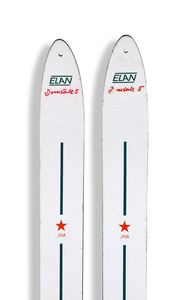
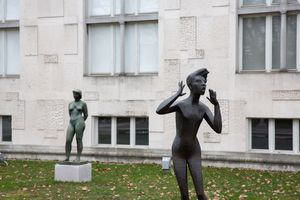

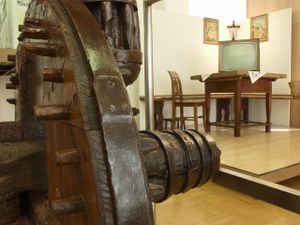
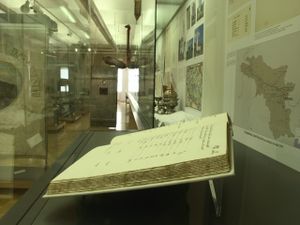
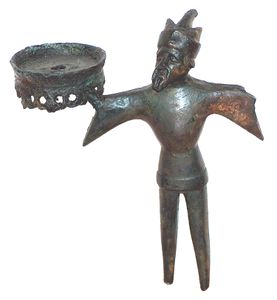
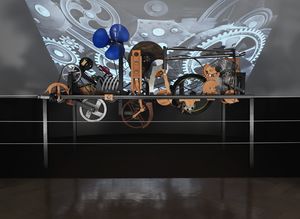
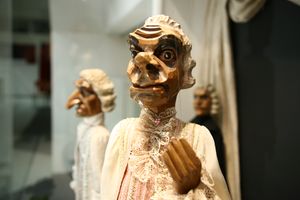
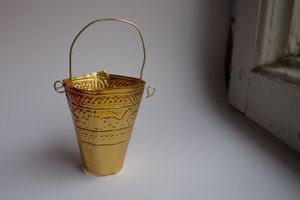
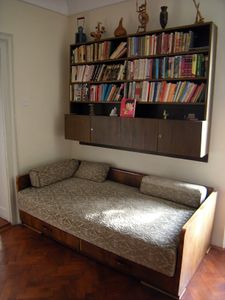
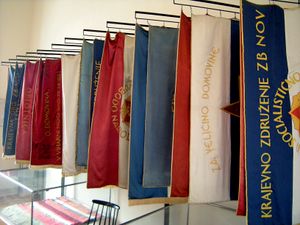
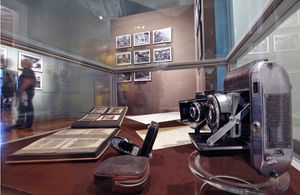
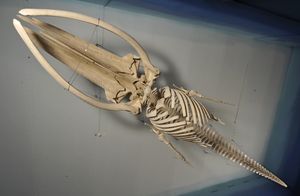
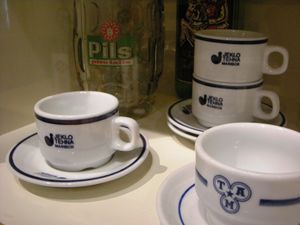
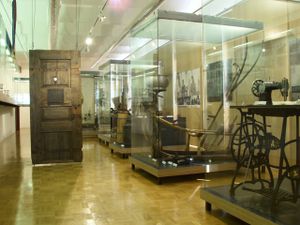
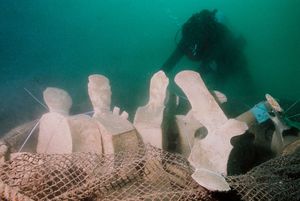

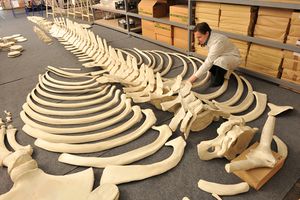
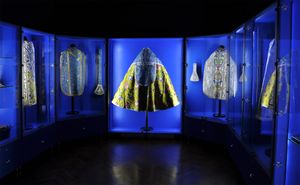
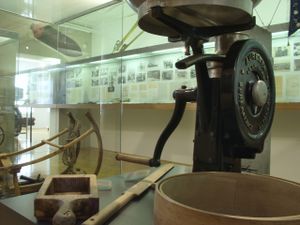
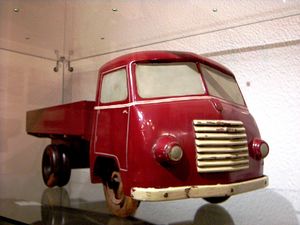
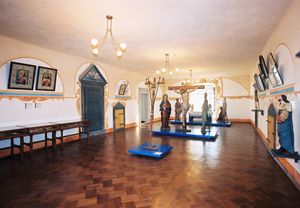
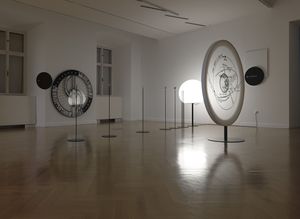
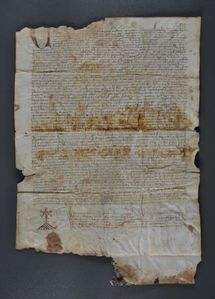
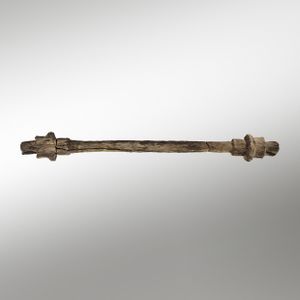
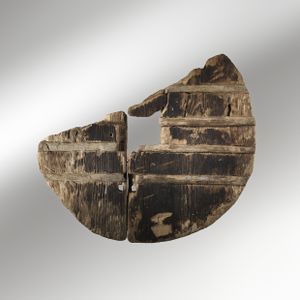
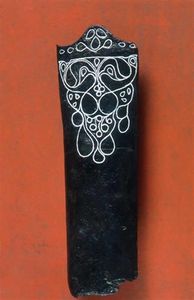
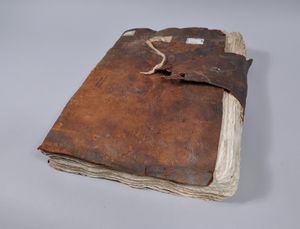
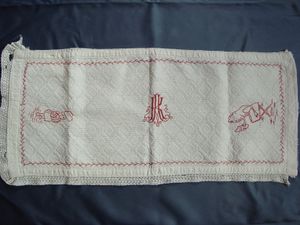
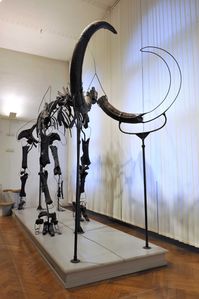
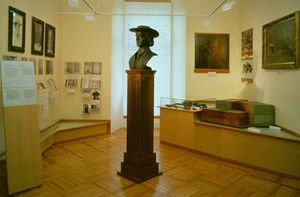
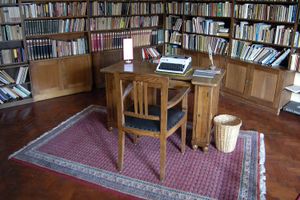
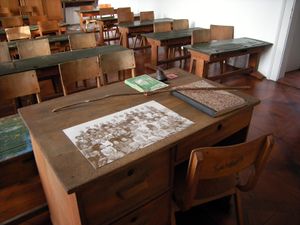
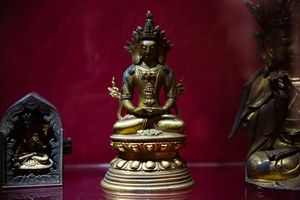

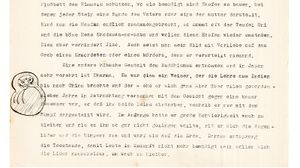
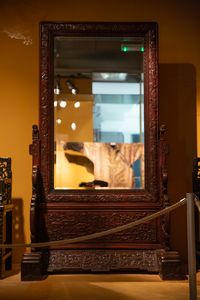
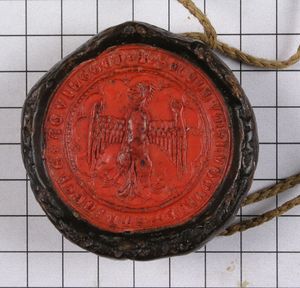

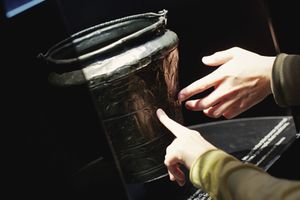

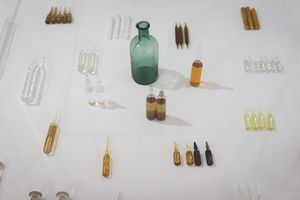
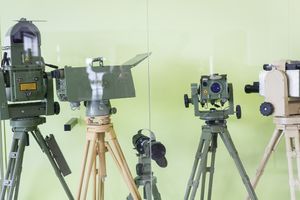
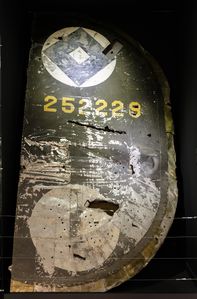
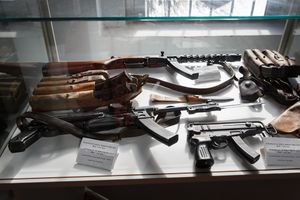
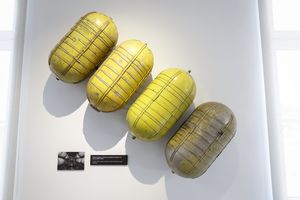
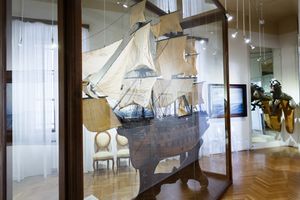
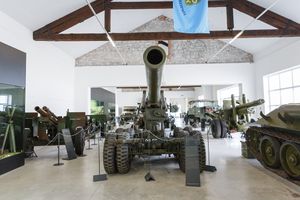
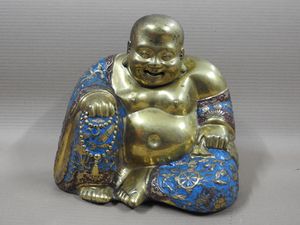

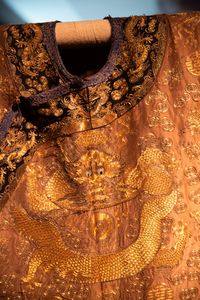

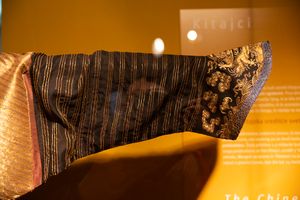
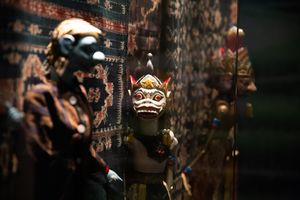

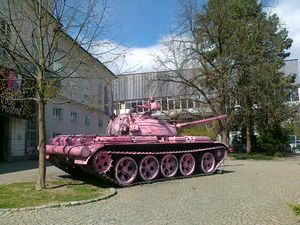
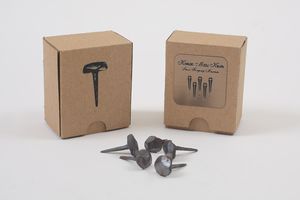
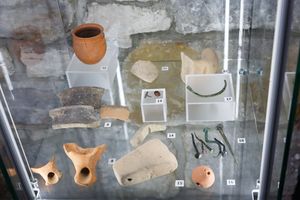
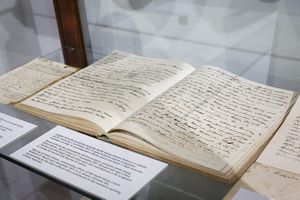
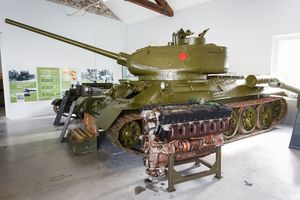
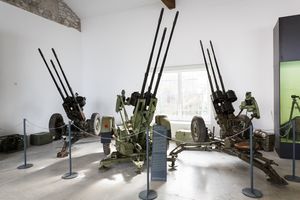

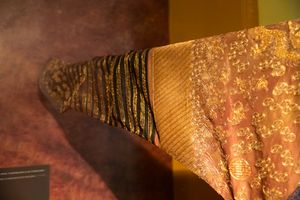
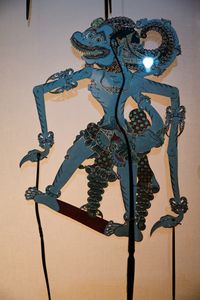

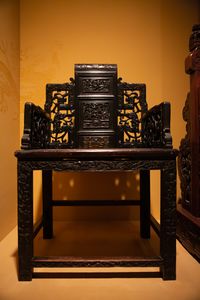
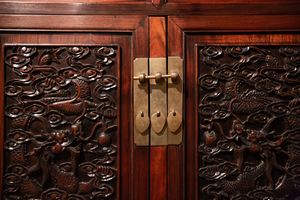
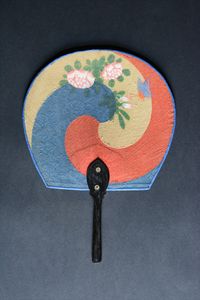

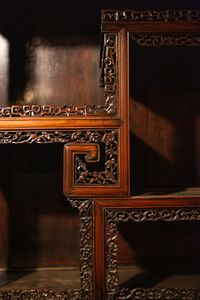
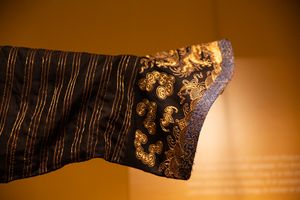
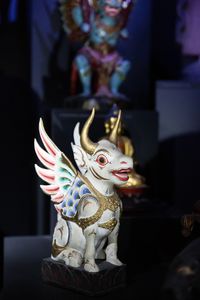
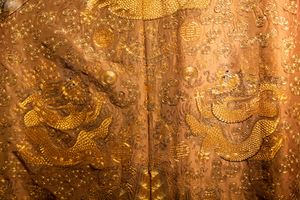
![The <!--LINK'" 0:85--> offers various souvenirs related to decorative metalwork. This particular candlestick is based on a design by the renowned architect [[::Category:Plečnik_heritage|Jože Plečnik]].](/images/thumb/7/76/Kropa_Iron_Forging_Museum_2017_A_souvenir_candlestick_following_Plecnik%27s_design_Photo_Gorazd_Kavcic.JPG/300px-Kropa_Iron_Forging_Museum_2017_A_souvenir_candlestick_following_Plecnik%27s_design_Photo_Gorazd_Kavcic.JPG)
